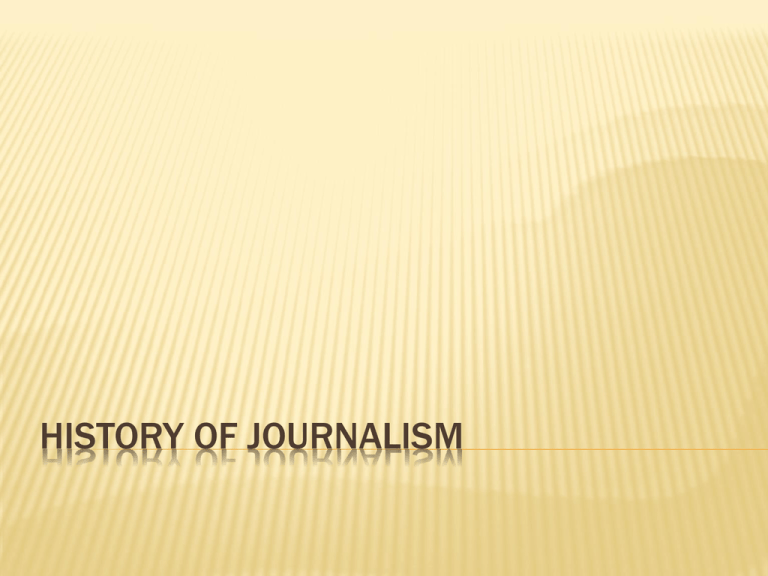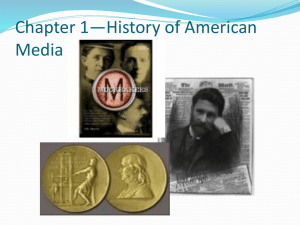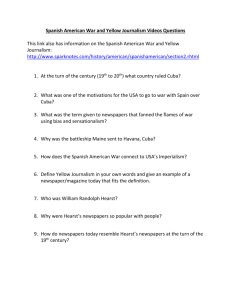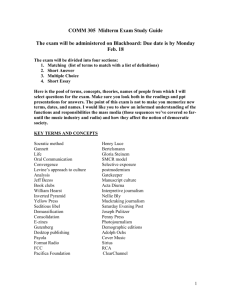History of Journalism PPT
advertisement

HISTORY OF JOURNALISM PUBLICK OCCURRENCES Published 1690. Only printed one paper because the British shut it down. ZENGER TRIAL 1735 establish truth as a defense against libel. You can print whatever you want as long as it’s true and you have the ability to show it’s true. Newspapers could be tried for sedition in the colonial times when they spoke out against the British government before the Zenger trial. REVOLUTIONARY WAR 1775 – Most papers allied themselves with the Patriots because of the taxes imposed upon them. Some historians argue that without the press there may not have been a revolution. Papers would print editorials blasting the British for their actions to alert citizens to the unfairness of the situation. FEDERALIST PAPERS The Federalist Papers: published between 1787 and 1788 in several New York State newspapers to persuade New York voters to ratify the proposed constitution. In total, the Federalist Papers consist of 85 essays outlining how this new government would operate and why this type of government was the best choice for the United States of America. All of the essays were signed "PUBLIUS" and the actual authors of some are under dispute, but the general consensus is that Alexander Hamilton wrote 52, James Madison wrote 28, and John Jay contributed the remaining five. Madison, widely recognized as the Father of the Constitution, would later go on to become President of the United States. Jay would become the first Chief Justice of the US Supreme Court. Hamilton would serve in the Cabinet and become a major force in setting economic policy for the US. The entire purpose of The Federalist Papers was to gain popular support for the then-proposed Constitution. Some would call it the most significant public-relations campaign in history; it is, in fact, studied in many public relations classes as a prime example of how to conduct a successful campaign FIRST AMENDMENT First Amendment – no law abridging the freedom of the press. Congress shall make no law respecting an establishment of religion, or prohibiting the free exercise thereof; or abridging the freedom of speech, or of the press; or the right of the people peaceably to assemble, and to petition the Government for a redress of grievances. PENNY PRESS Penny Press – early papers carried little news, mostly filled with letters, editorials, etc. However, the New York Sun in 1833 filled its paper with hard news (crime and natural disasters) and sold it for a penny. People bought it. CIVIL WAR The Civil War era brought technical advances like photography to the nation's great papers. The advent of the telegraph enabled Civil War correspondents to transmit stories back to their newspapers' home offices with unprecedented speed. But the telegraph lines often went down, so reporters learned to put the most important information in their stories into the first few lines of the transmission. This led to the development of the tight, invertedpyramid style of writing that we associate with newspapers today. This period also saw the formation of The Associated Press wire service, which started as a cooperative venture between several large newspapers wanting to share news that arrived by telegraph from Europe. Today the AP is the world's oldest and largest news agency. YELLOW JOURNALISM Yellow Journalism – late nineteenth century; involved hoaxes, altered photographs, frauds, and made up stories. William Randolph Hearst and Joseph Pulitzer’s papers were two of the most notable journalists. YELLOW JOURNALISM The sinking of the US Maine http://history.journalism.ku.ed u/1900/multimedia/video/Re membrMaine.mov Hearst http://history.journalism.ku.ed u/1900/multimedia/video/He artsWar.mov Spanish American War – 1895: newspapers whipped up a climate of war. Famous quote from Hearst to a reporter who was in Cuba and had nothing to report back on “Please remain. You furnish the pictures, and I’ll furnish the war.” Reporters stirred up trouble by reporting on the sinking of the ship “The Maine” saying it was sunk by the Spanish. Later, it was found the ship sunk because its boilers exploded. MUCKRAKERS This saw the end of yellow journalism around 1910. During this period, reporters crusaded for social rights such as better conditions in hospitals, child labor laws, and exposed public corruption. WILLIAM RANDOLPH HEARST Competitor with Joseph Pulitzer in the circulation wars in the age of yellow journalism. Publisher of The New York Journal. The paper fanned the flames of war and urged readers to "Remember the Maine" near the beginning of the Spanish-American War. He is quoted with the saying "war makes for great circulation." Hearst used the expansion of his newspaper chain to further his political ambitions. JOSEPH PULITZER Publisher of The New York World, Pulitzer was a crusader for the immigrants, the poor and the working class. Sensational headlines such as "Baptized in Blood" competed with Hearsts' sensationalism from The New York Journal. NELLIE BLY Famous muckraker who became personally involved in her stories. Ex: posing as a mental patient to expose the conditions people faced in mental facilities at the time. WWII AND THE 1940S Advances in technology, including the use of radio and television for news and entertainment, forced Americans to think more about the country's role in global affairs. The 1940s was a decade that transformed the lives of millions and set the tone for future social, political and economic reforms in the U.S. Unlike any other war, WWII was broadcast daily into people’s homes through radios. Source: http://history.journalism.ku.edu/ 1940/1940.shtml EDWARD R. MURROW Murrow had a profound impact on both radio and television. His ability to paint a picture with words brought him overnight success during his radio news reports from London during World War II. In fact, Murrow is often credited for inventing the radio correspondent. Murrow and his "boys" reported in gripping detail on the war in Europe. Source: http://history.journalism.ku.ed u/1940/1940.shtml http://history.journalism.ku.edu /1940/multimedia/video/Murro wLondon.mov 1950S Television slowly grabs attention away from radio and newspapers begin their decline during this decade. In addition to Murrow, famous broadcasters include: Mike Wallace and Walter Cronkite 1970S/GOVERNMENT EXPOSED This decade was known mainly for Watergate in which an indepth investigation by reporters Robert Woodward and Carl Bernstein which caused the resignation of President Richard Nixon (we will learn more about this later). The New York Times began publishing excerpts of the 7,000-page government study of the Vietnam War known as the Pentagon Papers. The document was originally leaked by a former Pentagon employee, Daniel Ellsberg. The U.S. government attempted to prohibit the publication, but the Supreme Court decided, in New York Times Co vs. United States, that the government actions were not justified. Source: http://history.journalism.ku.edu /1970/1970.shtml 1980S More and more news related sources are coming from the television with the advent of 24-hour news from brand new start up CNN. Also MTV is launched. 1990’S CNN’s coverage of the first Iraq war is unprecedented. Cameras and crew are in downtown Baghdad as bombs fall and anchors Bernard Shaw and Peter Arnett and John Holliman were huddled in a hotel room during the shelling. http://www.youtube.com /watch?v=wlC60Kef9Mg SOURCES http://history.journalism .ku.edu/1990/1990.sht ml






